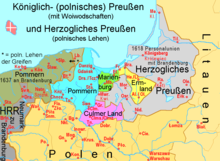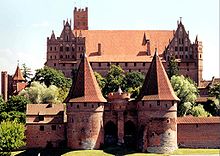Prussia (historical landscape)
Prussia is a historical landscape in north-eastern Central Europe with the centers Königsberg (today's Kaliningrad ), Marienburg and, to a limited extent, Gdansk .
Limits
The borders of the region named after the Baltic Prussians are not clear. However, the area between the Vistula and Memel rivers can roughly be referred to as Prussia. West of Prussia, Pomerania joins with Pommerellen . The easternmost part of Prussia was Prussian Lithuania . The eastern state border of Prussia has been one of the oldest in Europe since the peace of Lake Melno . It existed for over half a millennium until 1945.
After 1945 the former province of West Prussia and the southern half of the former East Prussia came to Poland. The northern half to the Memel is the Kaliningrad Oblast and the exclave of Russia . Prussian Lithuania (Little Lithuania) has become part of Lithuania .
The region is to be distinguished from the Kingdom of Prussia founded in 1701 with the center Berlin , which emerged from the personal union between the Mark Brandenburg and the Duchy of Prussia . The names of the later northeastern provinces of the Prussian state also refer to this: East Prussia and - only apparently absurd - West Prussia .
prehistory
Until the Middle Ages only the territory of the Baltic was tribe of the Prussians east of the lower Vistula "Prussia" called. The first mention of the name brus can be found in a list of peoples from the 9th century called the Bavarian Geographer . At the end of the century, the Anglo-Saxon traveler Wulfstan reported on his trip to the Prussian trading center Truso . In the Dagome Iudex , the regest of the document, with the Mieszko I of Poland in the 10th century his kingdom formally given to Pope John XV. It is said that Poland extends as far as the Prussian border ( fine Bruzze ).
German medal
Starting with Bolesław I. Chrobry , who sent Adalbert from Prague to Prussia and with him his own troops, the dukes and kings of Poland repeatedly tried to subdue the Prussians. When their counter-attacks became more and more threatening, the Polish Duke Konrad von Masowien called the Teutonic Order for help in 1226 , leaving the Kulmerland, which was already partly Slavic settled at the time . However, the order only became active beyond the Kulmerland after Emperor Friedrich II. In the Golden Bull of Rimini (1226 or 1235) and Pope Gregory IX. in the Bull of Rieti (1234) had assured full sovereignty over all areas to be conquered. The Teutonic Order subjugated the Prussians in the 13th century. During the protracted fighting, the southern and eastern peripheral areas were at times largely depopulated.
The Teutonic Order also conquered the Polish Duchy of Pomerania, west of the Vistula, with Danzig in 1308 . In the Treaty of Soldin (1309) the Duchy of Pomerania was divided between two German feudal states, the Margraviate of Brandenburg and the Teutonic Order , bypassing the rights of the Crown of Poland . In the course of the fragmentation of the Kingdom of Poland into provinces from 1138 onwards, the Pomeranian rulers from the Samborid family rose to become dukes from initially Polish governors in the early 13th century. Since the male line of Samborids became extinct in 1294, the Ascanian Waldemar (Brandenburg) also claimed the land. With the appropriation and division of Pomerania by the Teutonic Order State in 1308, the designation “Prussia” was extended to its acquisitions west of the Vistula.
Since the beginning of the subjugation of Prussia, the order called settlers from Germany and today's Netherlands into the country (cf. city name Preussisch Holland ). When the influx from the Holy Roman Empire subsided, immigrants from Mazovia , the Masurians , were settled in the south , and immigrants from Lithuania in the northeast, whose settlement area was called Lesser Lithuania, but never belonged to Lithuania until 1945.
Polish Crown and Hohenzollern

Colored: “Prussian royal share” divided into three voivodeships of Kulm, Marienburg and Pomerania and the prince-bishopric of Warmia combined in a union with the Polish crown;
Khaki: Lande Lauenburg and Bütow as pledge of the Dukes of Pomerania (political status of the year 1466)
In the Second Peace of Thorn in 1466 , the Kingdom of Poland, with the help of the Prussian League , which rebelled against the rule of the order, won Pomerania with Danzig, the Kulmerland , the Warmia and the Marienburg with the surrounding area . This area was called Latinized "Pruthenia Occidentalis" and politically Prussia royal share , since the Union of Lublin in 1569, also "Polish Prussia". The eastern part was converted into the secular Duchy of Prussia in 1525 by Albrecht (Prussia) , the last Grand Master of the Teutonic Order to rule in Prussia . King Sigismund I of Poland bestowed him hereditary ducal dignity . In 1618 the Hohenzollern electors of Brandenburg inherited the duchy, which at the time was still under Polish suzerainty , which became the nucleus of what would later become Prussia. In 1657, in the Treaty of Wehlau , the electors won sovereignty over Poland for the Duchy of Prussia and in 1701 finally the dignity of king. This was formally valid only for the area of the previous duchy, but the designation Kingdom of Prussia gradually established itself as a summarizing state name for all possessions of the Brandenburg-Prussian rulers, i.e. it also referred to the territories located in the Holy Roman Empire. In terms of constitutional law, the Hohenzollern monarchy consisted of two members of the empire until 1806/1807, the sovereign Kingdom of Prussia in the east and the partially sovereign Brandenburg Electorate in the empire to the west.
Brandenburg-Prussia
In 1772 the Prussian kings, who were also Electors of Brandenburg in the Holy Roman Empire, received the so-called Polish Prussia (Danzig and Thorn not until 1793), which belonged to I. Rzeczpospolita , in the course of the First Partition of Poland , as well as other areas adjacent to the south along the Netze . The sovereign Kingdom of Prussia, which was under the rule of the Hohenzollern in Brandenburg, was administratively divided into three parts in 1773: East Prussia , West Prussia and the Netzedistrikt .
With the fall of the Holy Roman Empire in 1806, the Hohenzollern monarchy gained complete sovereignty over its entire territory. This removed the special status of the Electorate of Brandenburg and the Brandenburg electoral dignity for the part of the Hohenzollern monarchy that was in the Holy Roman Empire. In the Peace of Tilsit , 1807, the Kingdom of Prussia, which had previously been expanded to include the Electorate of Brandenburg, lost most of the Netzedistikt and the Kulmerland to the Duchy of Warsaw , founded by Emperor Napoleon , but acquired them back at the Congress of Vienna in 1815. The network district was then largely added to the Prussian Grand Duchy of Posen . In 1829–78, East and West Prussia, and thus for the last time the historical Prussian landscape, were administratively united in the Province of Prussia .
The German Imperium
In 1871 - in contrast to its predecessor, the German Confederation - the entire territory of the Kingdom of Prussia became part of the German nation-state as a federal member. For the first time in its history (apart from the short period of the Paulskirche constitution 1848-1851) it was understood under the term " Germany " (although it was never precisely defined until then) ; previously it had never belonged to the Holy Roman Empire and only from 1848–1851 to the German Confederation. The majority of West Prussia was also not German-speaking . As a result of the long historical connection with Poland, Polish and Kashubian- speaking Catholics formed a large part of the population in Pomerania and Kulmerland . During the empire they saw themselves exposed to targeted exclusion and also Germanization . The Masurians and Lithuanians , however, were closer to the Prussian and German states because of their predominantly Lutheran faith.
Consequences of the world wars
After the German defeat in World War I and the Versailles Peace Treaty in 1919, West Prussia was largely defeated to Poland and the Memelland (since 1923 with Lithuania) and Danzig (as a Free City) separated. After all these areas fell again to the German Reich from 1939 to 1945, with the division of Germany, northern East Prussia was finally handed over to the Soviet Union and southern East Prussia to Poland and all Germans were expelled . Today the area of the historical Prussian landscape is divided into the Polish voivodeships of Pomerania and Kujawien-Pomerania (West Prussia) as well as Warmia-Masuria (southern East Prussia), the Russian Oblast Kaliningrad (northern East Prussia) and the Lithuanian administrative districts of Klaipėda and Tauragė district (Memelland) ).
literature
- William Pierson : electron or about the ancestors, the relatives and the names of the old Prussians. A contribution to the oldest history of the state of Prussia . Berlin 1869 ( full text ).
See also
- Portal: Prussia
- Flight and expulsion of Germans from Central and Eastern Europe 1945–1950
- Scriptores rerum Prussicarum
Web links
Individual evidence
- ↑ Christoph Hartknoch , Prussian Churches Historia
- ^ Wording of the Golden Bull of Rimini
- ↑ Publications on the Rieti bull in the OPAC of the Regesta Imperii


